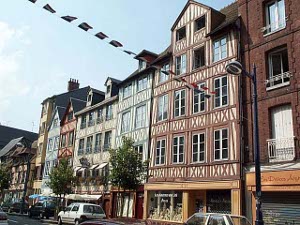 Monet's garden
Monet's garden
We were excited and delighted to connect with Dan in Paris. His luggage for two weeks was heavier than ours, but then he can press 300 pounds, so we didn't worry too much. Fifteen-year-old boys are like Superman, and Dan was no exception.
 Monet's garden
Monet's garden
Our rental car was large and comfortable. Dan rode shotgun, so he could see better. Our goal was to keep him awake all day to overcome the 9-hour jet lag as quickly as possible. He was a pretty good trooper. We asked him how to drive, and he said not on the freeways, take the scenic roads, so we did.
Our plan was to visit Normandy, as Dan had just learned in history class about the second world war. This turned out to be an inspired decision; Normandy was new to us, and we felt we learned just as much as Dan did.
The scenic way to get to Normandy from Paris is to go down the Seine, and that (approximately) is just what we did. The Michelin maps are really great. The dark red autoroutes, or freeways, we avoided. The plain red roads were good highways; the yellow roads were curvy but well-maintained, and the white roads were often narrow, but would plunge through interesting villages. We generally took a mixture of yellow and white roads.
 Monet's lilies
Monet's lilies
Soon we spotted a familiar name on the map: Giverny, home of the water lilies of Claude Monet. Dan has been studying the Impressionists including Monet. We decided to make that our first official sightseeing stop, and, along with hundreds of other tourists, we pulled into the parking lot.
Visitors approach the Monet garden by walking through the tiny and quaint village of Giverny The flower gardens were in full bloom, lavish displays of pinks and blue and yellow and scarlet and innumerable other colors, many swaying on tall stems. (We overheard one English visitor remark that the garden was too wild for his taste). After admiring the flower garden and peeking into the various rooms of his house, we found the path to the water lilies.
Again, we were in luck and could well understand the reason that the gardens are packed with tourists. The water lilies were also in lavish, full bloom, looking like porcelain on saucers of leaves. We enjoyed mentally comparing the real-life scenes with the familiar paintings (and we looked forward  Rouen public square
to showing more paintings, at the Musee d'Orsay, to Danny in another week).
Rouen public square
to showing more paintings, at the Musee d'Orsay, to Danny in another week).
We arrived in Rouen toward the end of the afternoon, found a hotel, where the manager gave us some very good advice. He produced a map, told us how to leave by the back door of the hotel, where children were splashing in a fountain, and which roads to follow as we walked downtown. This walk kept on getting better and better, as we discovered that many very old timbered buildings in Rouen have escaped destruction from the wars. The town is exceptionally attractive, the old buildings well maintained. Le Gros Horloge is an enormous old clock in an building over the road.
Dan could not believe the enormous height of the cathedral spire. It was was the first large gothic cathedral he had seen, and his eyes popped out of his head. We had lots of grandparently work to do explaining the parts of the cathedral, their meaning and use. Of course we were delighted that he showed such an enthusiastic interest in history; it's certainly a subject that never runs out of surprises.
And in Rouen there's lots to talk about. Here, in 1431, Joan of Arc was tried and burned at the stake, and a lovely modern church has been built in honor of St. Joan, the patron saint of France.
We kept 51 photos this day, and can only include a couple. Write us if there's a particular subject of which you'd like to see photos.